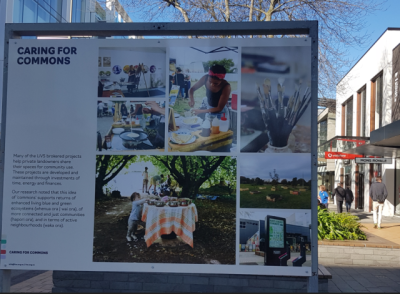Celebrating 10 years of place-making in Ōtautahi Christchurch

In the ten years since the devastating Canterbury earthquakes resulted in 80 per cent of the buildings in central Ōtautahi Christchurch being demolished, a charitable trust has supported more than 700 projects focused on place-making and urban wellbeing.
The work of Life in Vacant Spaces (LiVS) is being celebrated with an outdoor exhibition along Cashel St Mall in Ōtautahi Christchurch from 13 to 29 September 2022, and the upcoming launch of a book, Huritanga: 10 Years of Transformational Place-Making.
Community Economies Institute (CEI) member Kelly Dombroski is a member of the LiVS Board, and she has drawn on her community economies expertise to analyse the impacts of the projects supported by LiVS.
She says, “We used a qualitative analysis to explore the multi-dimensional nature of the investments and returns from the projects.”
“In the book, we organise the returns in terms of the ethical concerns identified by JK Gibson-Graham, Jenny Cameron and Stephen Healy in Take Back the Economy (2013), and this means we have chapters that address the following questions:
- How do we survive together well and equitably?
- How do consume sustainably?
- How do we encounter others in ways that support mutual wellbeing?
- How do we distribute surplus in order to enrich social and environmental health?
- How do we care for the commons that sustain us all?
- How do we invest in future generations?”
The book also draws on the Mauri Ora Urban Wellbeing Compass, a ground breaking tool by Community Economies Research Network (CERN) member Amanda Yates (Ngāti Rangiwewehi, Ngāti Whakaue, Te Aitanga a Māhaki, Rongowhakaata) to visualise and name various aspects of holistic urban wellbeing.
Yates says, “In Te Ao Māori, mauri is understood as the life force inherent in all, and things can be in a state of mauri ora (holistic wellbeing), mauri noho (stasis) or mauri mate (decline and illness). The Mauri Ora Compass helps to identify how an urban place might navigate towards mauri ora and away from mauri mate.”
“We can use this tool to identify urban actions that will help make a transition to wellbeing in the areas of environment, building, community, economy, transport/access, and energy.”
The exhibition and book were produced in collaboration with LiVS, and included curator and editor Rachael Shiels, photographer Hannah Watkinson and designer Jen McBride.
For the exhibition component, the team created large billboards with photos and text, celebrating the actions of the projects and organisations in terms of surviving well, caring for commons and encountering others. At the end of the exhibition, the billboards will be offered back to the community organisations or stored to be reused in future exhibition work.
Image: Kelly Dombroski
Jenny Cameron
